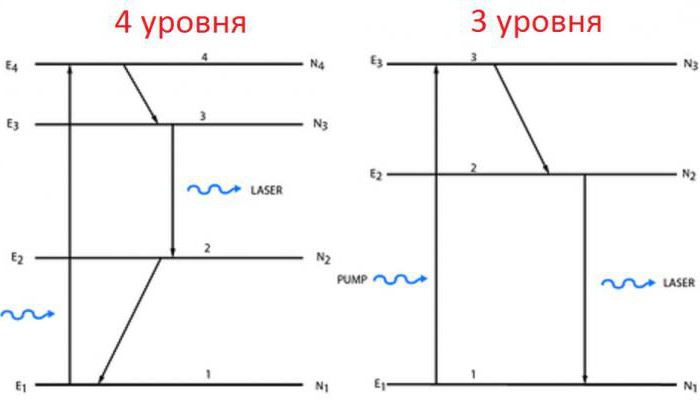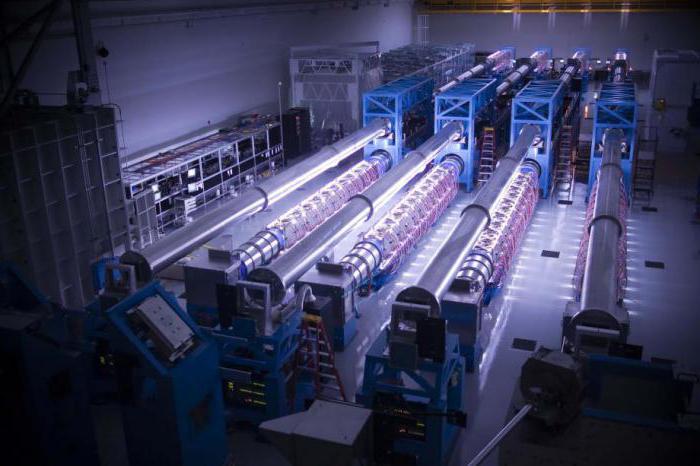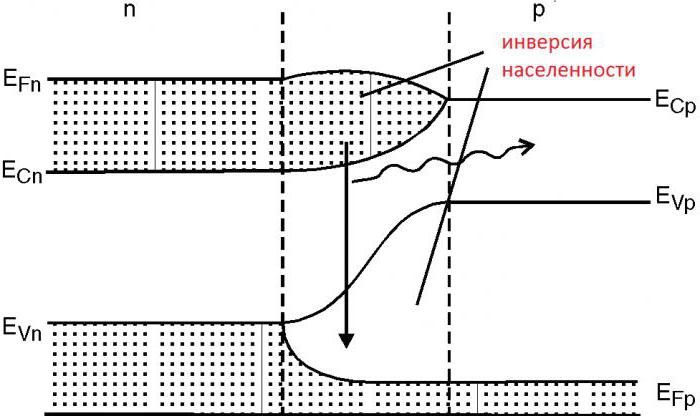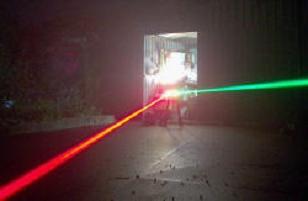The first principle of the laser, whose physicsbased on Planck’s radiation law, theoretically substantiated by Einstein in 1917. He described absorption, spontaneous and stimulated electromagnetic radiation using probability coefficients (Einstein coefficients).
Pioneers
Theodore Meiman was the first to demonstrateprinciple of operation of a ruby laser, based on optical pumping using a flash lamp of a synthetic ruby, producing pulsed coherent radiation with a wavelength of 694 nm.
In 1960, Iranian scientists Javan and Bennett created the first gas quantum generator using a mixture of He and Ne gases in a ratio of 1:10.
In 1962 R.N.Hall demonstrated the first gallium arsenide (GaAs) diode laser, emitting at a wavelength of 850 nm. Later that year, Nick Golonyak developed the first semiconductor quantum generator of visible light.

The device and principle of operation of lasers
Each laser system consists of an activemedium placed between a pair of optically parallel and highly reflective mirrors, one of which is translucent, and the energy source for pumping it. The medium of amplification can be a solid, liquid or gas, which has the property of amplifying the amplitude of a light wave passing through it, by stimulated emission with electric or optical pumping. The substance is placed between a pair of mirrors in such a way that the light reflected in them passes through it each time and, having reached a significant gain, penetrates a semi-transparent mirror.

Two-tier environments
Consider the principle of operation of a laser with an active medium, the atoms of which have only two levels of energy: excited E2 and base E1. If atoms using any pumping mechanism (optical, electrical discharge, current transmission or electron bombardment) are excited to state E2then after a few nanoseconds they will return to the main position, emitting photons of energy hν = E2 - E1. According to Einstein’s theory, emissions are madein two different ways: either it is induced by a photon, or it happens spontaneously. In the first case, stimulated emission occurs, and in the second - spontaneous. At thermal equilibrium the probability of stimulated emission is much lower than spontaneous (1:1033), therefore, most conventional light sources are incoherent, and lasing is possible in conditions other than thermal equilibrium.
Even with very high pumping populationtwo-tier systems can only be made equal. Therefore, to achieve the inverse population by optical or other pumping method, three- or four-level systems are required.

Multi-level systems
What is the principle of the three-level laser? Irradiation with intense light of frequency ν02 pumps a large number of atoms from the lowest energy level E0 to the top E2. Nonradiative transition of atoms with E2 to E1 sets population inversion between E1 and E0that in practice it is possible only when the atoms are in the metastable state E for a long time1, and the transition from E2 to E1 going fast. The principle of the three-level laser is to meet these conditions, so that between E0 and E1 population inversion is achieved and photons are amplified by energy E1-E0 induced radiation. Wider level E2 could increase the absorption range of wavelengths for more efficient pumping, resulting in an increase in stimulated emission.
The three-tier system requires very highpumping power, since the lower level involved in the generation is basic. In this case, in order for the population inversion to occur, to state E1 должно быть накачано более половины от общего numbers of atoms. In this case, energy is wasted. The pump power can be significantly reduced if the lower generation level is not basic, which requires at least a four-level system.
Depending on the nature of the active substance,Lasers are divided into three main categories, namely, solid, liquid and gas. Since 1958, when the generation of a ruby crystal was first observed, scientists and researchers have studied a wide range of materials in each category.

Solid state laser
The principle of operation is based on the use of the active medium, which is formed by adding a transition group (Ti) to the insulating crystal lattice of the metal.+3Cr+3, AT+2, With+2Ni+2Fe+2, etc.), rare earth ions (Ce+3Pr+3Nd+3Pm+3, Cm+2, Eu+ 2, + 3, Tb+3Dy+3Ho+3Er+3Yb+3, etc.), and actinides like U+3. Energy levels of ions are responsible only forgeneration The physical properties of the base material, such as thermal conductivity and thermal expansion, are important for efficient laser operation. The arrangement of lattice atoms around the doped ion changes its energy levels. Different generation wavelengths in the active medium are achieved by doping different materials with the same ion.
Holmium laser
An example of a solid-state laser is a quantuma generator in which holmium replaces an atom of the base substance of the crystal lattice. Ho: YAG is one of the best generating materials. The principle of operation of a holmium laser is that an yttrium aluminum garnet is doped with holmium ions, optically pumped with a flashlight and emits at a wavelength of 2097 nm in the IR range, which is well absorbed by the tissues. This laser is used for operations on the joints, in dental treatment, for evaporation of cancer cells, kidney and gallstones.

Semiconductor quantum oscillator
Лазеры на квантовых ямах недороги, позволяют mass production and easy to scale. The principle of operation of a semiconductor laser is based on the use of a pn junction diode, which produces light of a specific wavelength by recombining the carrier with a positive bias, like LEDs. LED emit spontaneously, and laser diodes - forced. To fulfill the population inversion condition, the operating current must exceed a threshold value. The active medium in a semiconductor diode has the form of a connecting region of two two-dimensional layers.
The principle of operation of a laser of this type is such thatno external mirror is required to maintain the vibrations. The reflectivity created by the refractive index of the layers and the internal reflection of the active medium is sufficient for this purpose. The end surfaces of the diodes are cleaved, which ensures parallel reflective surfaces.
A compound formed by semiconductor materials of the same type is called a homojunction, and a compound made of two different ones is called a heterojunction.
Semiconductors of p and n types with high carrier density form a pn junction with a very thin (≈1 μm) depleted layer.

Gas laser
The principle of operation and use of the laser istype allows you to create devices of virtually any power (from milliwatts to megawatts) and wavelengths (from UV to IR) and allows you to work in pulsed and continuous modes. Based on the nature of active media, there are three types of gas quantum generators, namely atomic, ionic, and molecular.
Большинство газовых лазеров накачиваются electric discharge. The electrons in the discharge tube are accelerated by the electric field between the electrodes. They collide with atoms, ions or molecules of the active medium and induce a transition to higher energy levels to achieve the state of population inversion and stimulated radiation.

Molecular laser
The principle of operation of the laser is based on the fact that, inUnlike isolated atoms and ions, in atomic and ionic quantum generators, molecules have wide energy zones of discrete energy levels. In addition, each electronic energy level has a large number of oscillatory levels, and those, in turn, are somewhat rotational.
Energy between electronic energyThe levels are in the UV and visible regions of the spectrum, while between the vibrational-rotational levels in the far and near IR regions. Thus, most molecular quantum generators operate in far or near IR regions.
Excimer lasers
Excimers are such molecules asArF, KrF, XeCl, which have a separated ground state and are stable at the first level. The principle of the laser is as follows. As a rule, in the ground state the number of molecules is small; therefore, direct pumping from the ground state is not possible. Molecules are formed in the first excited electronic state by combining high-energy halides with inert gases. The population of inversion is easily achieved, since the number of molecules at the basic level is too small compared to the excited one. The principle of operation of a laser, in short, consists in the transition from the bound excited electron state to the dissociative ground state. The population in the ground state always remains low because the molecules at this point dissociate into atoms.
The device and the principle of operation of lasers is that the discharge tube is filled with a mixture of halide (F2) and rare earth gas (Ar). The electrons in it dissociate and ionize the halide molecules and create negatively charged ions. Positive Ar ions+ and negative f- react and produce ArF molecules in the firstan excited bound state with their subsequent transition to a repulsive baseline state and the generation of coherent radiation. The excimer laser, the principle of operation and the application of which we are now considering, can be used to pump the active medium on dyes.
Liquid laser
Compared to solids, liquidsmore homogeneous, and have a higher density of active atoms, compared with gases. In addition to this, they are not difficult to manufacture, allow you to simply remove heat and can be easily replaced. The principle of the laser is to use as an active medium organic dyes, such as DCM (4-dicyanomethylene-2-methyl-6-p-dimethylaminosthenyl-4H-pyran), rhodamine, styryl, LDS, coumarin, stilbene, etc. . dissolved in an appropriate solvent. The solution of dye molecules is excited by radiation, the wavelength of which has a good absorption coefficient. The principle of the laser, in short, is to generate at a longer wavelength, called fluorescence. The difference between the absorbed energy and the emitted photons is used by non-radiative energy transitions and heats the system.
Wider Fluorescence Bandquantum generators has a unique feature - wavelength tuning. The principle of operation and use of a laser of this type as a tunable and coherent light source is becoming increasingly important in spectroscopy, holography, and biomedical applications.
Recently, quantum dye generators have been used to separate isotopes. In this case, the laser selectively excites one of them, prompting a chemical reaction.











